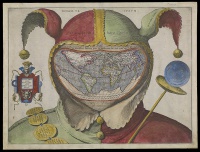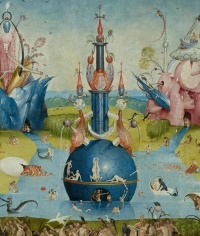Globe
From The Art and Popular Culture Encyclopedia

_.jpg)
|
“The terrestrial globe is covered with volcanoes, which serve as its anus” [1] --G. Bataille |

|
Related e |
|
Featured: |
A globe is a three-dimensional scale model of Earth (terrestrial globe) or other spheroid celestial body such as a planet, star, or moon. It may also refer to a spherical representation of the celestial sphere, showing the apparent positions of the stars and constellations in the sky (celestial globe). The word "globe" comes from the Latin word globus, meaning round mass or sphere.
History
The sphericity of the Earth was established by Greek astronomy in the 3rd century BC, and the earliest terrestrial globe appeared from that period. The earliest known example is the one constructed by Crates of Mallus in Cilicia (now Çukurova in modern-day Turkey), in the mid-2nd century BC.
No terrestrial globes from Antiquity or the Middle Ages have survived. An example of a surviving celestial globe is part of a Hellenistic sculpture, called the Farnese Atlas, surviving in a 2nd-century AD Roman copy in the Naples Museum, Italy.
Early terrestrial globes depicting the entirety of the Old World were constructed in the Islamic world. According to David Woodward, one such example was the terrestrial globe introduced to Beijing by the Persian astronomer, Jamal ad-Din, in 1267.
The oldest surviving terrestrial globe is the Erdapfel, created by Martin Behaim in Nuremberg, Germany, in 1492.
Another early globe, the Hunt-Lenox Globe, ca. 1510, is thought to be the source of the phrase Hic Sunt Dracones, or “Here be dragons”. A similar grapefruit-sized globe made from two halves of an ostrich egg was found in 2012 and is believed to date from 1504. It may be the oldest globe to show the New World. Stefaan Missine, who analyzed the globe for the Washington Map Society journal Portolan, said it was “part of an important European collection for decades.” After a year of research in which he consulted many experts, Missine concluded the Hunt-Lenox Globe was a copper cast of the egg globe.
A facsimile globe showing America was made by Martin Waldseemueller in 1507. Another “remarkably modern-looking” terrestrial globe of the Earth was constructed by Taqi al-Din at the Istanbul observatory of Taqi al-Din during the 1570s.
The world’s first seamless celestial globe was built by Mughal scientists under the patronage of Jahangir.
Globus IMP electro-mechanical devices including five-inch globes have been used in Soviet and Russian spacecraft from 1961 to 2002 as navigation instruments. In 2001, the TMA version of the Soyuz spacecraft replaced this instrument with a virtual globe.
The first terrestrial globe was made in 1492 by Martin Behaim (1459–1537) with help from the painter, Georg Glockendon. Behaim was a German mapmaker, navigator, and merchant. He called his first invention of the globe “Nürnberg Terrestrial Globe.” Behaim sailed to different places before he invented the globe. He sailed to Portugal in 1480 as a merchant, to inform King John II about navigation. He then went on a voyage to the coast of West Africa with the Portuguese explorer Diogo Cão in 1485–1486; during the trip, he discovered the Congo River. After his return to Nürnberg in 1490, he then began to construct his globe, which seemed inadequate at that time. During the time that Behaim made the globe, there were many blank spots in the map. On the same year that the globe was made, Christopher Columbus landed in a place he thought was the East Indies. But another explorer named Amerigo Vespucci realized that it was the ‘gap’ on Behaim’s globe. The continent of North and South America had been unknown to the people of Europe and Asia until 1492. The new continent was named America by Martin Waldseemueller, a man of the cloth, map and globe maker by trade. Explorers were sent out by emperors, kings, and queens to find and conquer a new land. Upon their return, they would tell their stories of their journey. Soon, the blank spots were disappearing. After years of filling the gaps, the globe has been completed. The globe later then expanded and manufactured to different places. It first started out from Nuremberg, where Behaim started the making, then later to Amsterdam, followed by Venice, Paris, Rome, and London. The United States were last to manufacture in 1810 by James Wilson.
See also
.jpg)

